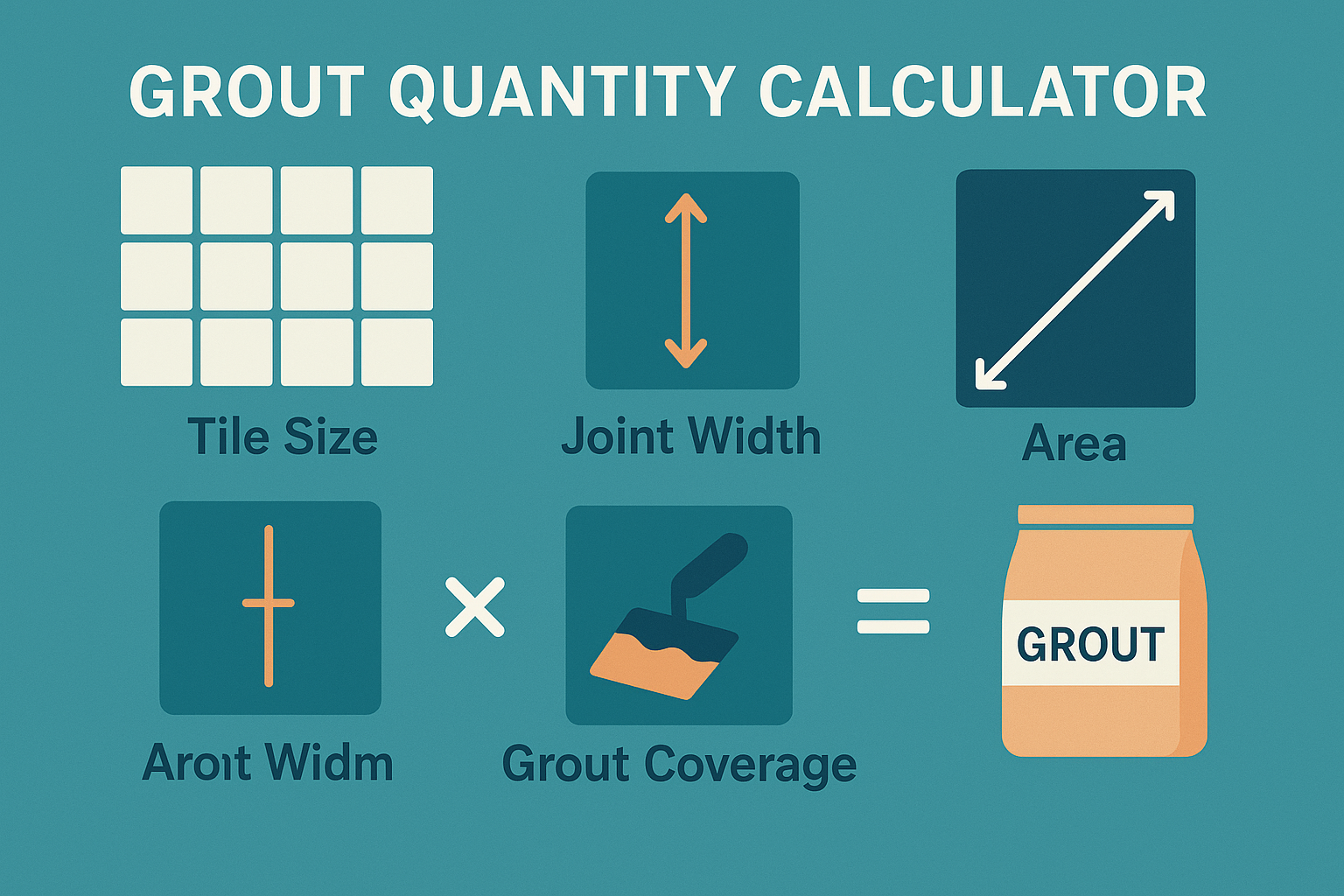Free Grout Quantity Calculator Online
Accurately estimating the amount of grout required for a tiling or masonry project is essential for both small home renovations and large-scale construction jobs. A grout quantity calculator from Construction Calculators simplifies this process by calculating the total grout volume needed based on tile dimensions, joint width, depth, and surface area. Whether you’re laying ceramic tiles in a bathroom or installing stone cladding on an exterior wall, this tool ensures optimal planning and minimal material waste.
What Is a Grout Quantity Calculator?
A grout quantity calculator is a construction tool designed to estimate the amount of grout required to fill joints between tiles or masonry blocks. It factors in the size of the tiles, the spacing between them, and the overall surface area to be tiled. It can be applied to a variety of projects, including wall tiles, floor tiles, backsplashes, and large facade cladding. The calculator provides results in pounds or kilograms, and often in volume as cubic meters or liters, depending on the unit system selected.

Why Use a Grout Quantity Calculator?
Using a grout calculator prevents under- or over-ordering materials, which saves money and helps streamline the construction timeline. Proper grout estimation:
- Prevents job site delays
- Reduces material wastage
- Ensures uniform joint filling
- Supports budget-friendly planning
- Helps meet quality and structural standards
Grout plays a vital role in maintaining tile alignment and providing resistance against moisture and dirt. Using the right amount is key to achieving both function and aesthetics.
Key Inputs for Grout Calculation
To determine how much grout you need, the calculator requires the following inputs:
- Tile Length (in inches or mm)
- Tile Width (in inches or mm)
- Tile Thickness (optional, affects joint depth)
- Joint Width (in inches or mm)
- Joint Depth (typically equals tile thickness)
- Total Area to be tiled (in square feet or square meters)
- Tile Gap Pattern (square, brick, herringbone, etc.)
The precision of your grout estimate improves significantly with accurate input data. Advanced calculators may even adjust for tile waste or pattern variations.
Grout Quantity Formula
A standard formula used to calculate grout volume is:
To convert to cubic feet:
To convert volume to weight:
Typical grout densities range from 110 to 140 lbs per cubic foot depending on type and manufacturer.
Example Calculation
Let’s say you are tiling an area of 100 sq ft using tiles that are 12″ x 12″ with a 1/8″ joint width and 1/4″ joint depth. Plugging into the formula:
Assuming grout density of 130 lbs/cu ft:
Factors Affecting Grout Quantity
Several site-specific and material-related conditions can influence grout needs:
- Tile Size and Pattern: Larger tiles mean fewer joints and less grout.
- Joint Width and Depth: Wider and deeper joints increase grout volume.
- Tile Waste: Breakage or cutting increases the total joint length.
- Surface Porosity: Highly porous tiles may absorb more grout.
- Application Method: Trowel size and grout spreading technique affect actual usage.
- Grout Type: Sanded, unsanded, epoxy, and polymer-modified grouts have different densities.
Considering these variables helps fine-tune your grout estimate.
Benefits of Using a Grout Calculator
Using a grout calculator offers multiple advantages:
- Prevents overbuying: Helps avoid buying excess material.
- Optimizes budgeting: Makes cost planning more precise.
- Reduces waste: Supports eco-friendly project execution.
- Saves time: Minimizes interruptions during application.
- Improves results: Helps achieve clean, consistent grout lines.
Whether you’re a DIY tiler or a professional contractor, it improves project accuracy and execution.
Common Applications
Grout calculators are useful for a wide range of tiling and masonry projects:
- Floor tile installations (bathrooms, kitchens, hallways)
- Wall tiles (backsplashes, shower walls, accent walls)
- Outdoor patios and pool areas
- Natural stone or veneer masonry
- Commercial tiling in malls, hospitals, and schools
Additional Tools to Use with Grout Calculator
- Tile Quantity Calculator: Determines the number of tiles required.
- Thinset Calculator: Estimates adhesive needs for setting tiles.
- Surface Area Calculator: Accurately measures tiled zones.
- Mortar Mix Calculator: Assists with block or brick masonry work.
These tools together form a comprehensive planning system for tile-based construction projects.
Tips for Successful Grout Application
- Always follow the manufacturer’s recommendations for water-to-grout ratio.
- Use spacers to maintain uniform joint width.
- Mix only as much grout as you can apply within 30 minutes.
- Remove excess grout quickly to avoid surface staining.
- Allow proper curing time (24–72 hours) before exposure to moisture.
These best practices lead to better durability and aesthetics.
Conclusion
A grout quantity calculator is an invaluable tool for any tiling or masonry project. It empowers users to accurately estimate grout needs, control costs, and improve workmanship quality. Whether you’re sealing kitchen backsplash tiles or finishing a large commercial floor, precise grout planning helps complete the job on time and within budget. Available on the Concrete Calculators platform, this tool pairs well with other resources like the Rebar Spacing Calculator and the Concrete Paver Calculator to help ensure accurate prep, smart material use, and lasting results across all phases of your project.
